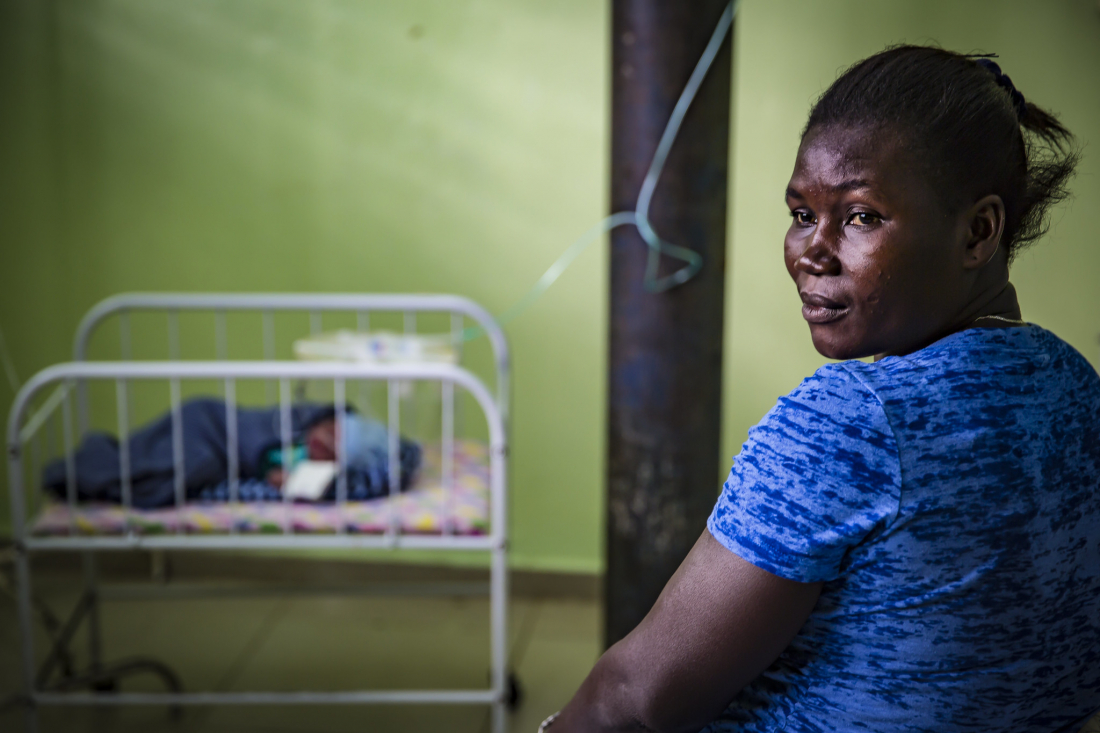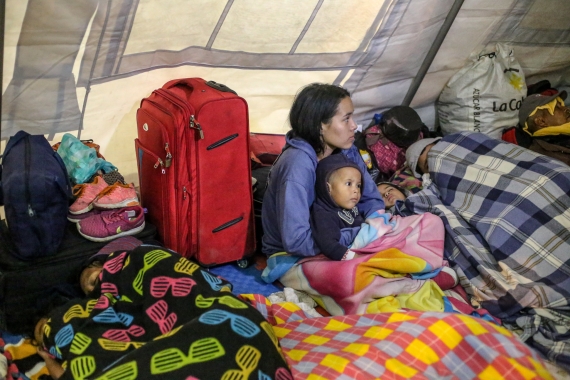Five Steps to Strengthen Health Access for Migrant Women
Subtitle
A Locally Led Example from the Dominican Republic
A Locally Led Example from the Dominican Republic
Date

A Haitian woman and her infant receive care at Hospital Ramon Matias Mella in the DR. (Photo: © 2018 European Union licensed under CC BY-NC-ND 2.0)
By Sarah Insanally
In the Latin America and Caribbean (LAC) region, women in low-income settings and ethnic minority groups are affected by persistent health inequalities.[1][2] On top of this, women are likely to bear the brunt of the COVID-19 crisis in the region, including increased violence and disruption of sexual and reproductive health services.[3] The outlook is even worse for women migrants, who face multiple risks throughout the migration journey.[4] In the Dominican Republic (DR), the dual impact of large numbers of migrants and a health system overwhelmed by COVID-19 has meant that fewer health services are available for migrant women.[5]
USAID’s Local Health System Sustainability Project (LHSS) is working in the DR to improve health protection for the country’s migrant women, most of whom come from Haiti. Our approach rests on the belief that programs for improving access to health services can succeed only if they are defined and led by local actors and reflect the lived experiences, priorities, and preferences of migrants and host communities. With this in mind, we built our approach in the DR around five elements.
1. Let local stakeholders guide the process
Improving health access for migrant women in a way that is sustainable is a long-term undertaking. It requires local champions who are committed to moving the work forward beyond the timeframes and scopes of development partner assistance. In the DR, we partnered with Two Oceans in Health, a Dominican organization known for its methodological rigor and experience working to improve health programs for vulnerable groups. Two Oceans is uniquely positioned to guide a process to promote consensus among government, private sector, and community leaders on feasible actions to improve health outcomes for both migrant women and their host communities.
2. Understand the country context
While health system data provide part of the picture, it’s critical to learn directly from migrants and those who work with them to fully understand their perspectives, priorities, and needs. A consultative process facilitated by Two Oceans revealed important insights, including that most migrants access health services at emergency rooms and hospitals rather than in more cost-effective primary care settings.[6] This and other key findings are detailed in the LHSS report, Expanding social health protection to migrant women in the Dominican Republic.[7]
3. Create a shared vision
Improving services for migrants can be a sensitive and polarizing issue in any country, especially when government resources are already stretched thin and access to services is influenced by non-health policies on migration. Tackling such challenges requires diverse interest groups to agree on national priorities.
In the DR, Two Oceans brought together -- for the first time -- leaders from government health and non-health agencies, the private sector, civil society, and migrant and host communities to form a working group. As a first step, the group agreed on a strategic vision: Every person residing in or transiting through the DR has equitable access to quality essential health services, regardless of his or her nationality, age, gender, or migratory status. Two Oceans then engaged 22 organizations to develop a five-year roadmap detailing feasible and sustainable interventions, stakeholder responsibilities, required capabilities, and timelines for sequence implementation.
The roadmap focuses on five health system enhancements: strengthening intersectoral coordination; engaging Haitian doctors; providing temporary health ID cards to migrants; standardizing the primary care services package; and improving data quality and availability.
4. Determine gaps and solutions to address them
The roadmap focuses on addressing health system gaps in five main areas: strengthening intersectoral coordination, including with agencies responsible for migration policy; engaging Haitian doctors living in the DR; providing temporary health identification cards to migrants; defining and standardizing the package of services provided at primary care facilities in areas with many migrants; and improving data quality and availability through the rollout of registries at health facilities.
Across these areas, long-term success depends on ensuring that interventions are integrated into the national health system. As the Roadmap interventions are rolled out, it will be important to document and demonstrate financial and health impacts and to support the government’s exploration of funding sources to continue efforts. The working group will also lead efforts to counter misconceptions that fuel xenophobia, including by raising awareness of the benefits of migration for the DR.[8]
5. Communicate, communicate, communicate
A locally led systems approach requires participation from diverse stakeholders who may not already have ways to share information and ideas. Consistent two-way communication with migrant beneficiary communities is particularly important – for example, to gather feedback about health system enhancements, share information about improvements, and encourage the use of health services. We do this by engaging civil society organizations that work directly with migrants.
Where do we go from here?
Over the next year, LHSS will continue working with Two Oceans to help local partners implement the roadmap and generate evidence for sustainable financing of approaches that improve access to and quality of health services for migrants. The next key step is to work with the Ministry of Health to define and pilot a package of primary health services at an initial cluster of health facilities that serve areas with high numbers of migrants.
Even in the highly complex context of major migration and a global pandemic, change is possible when all stakeholders have a voice in the process. We look forward to sharing updates and more lessons from LHSS's experience in the LAC region in the coming months.
Notes:
[1] https://iris.paho.org/bitstream/handle/10665.2/774/9789275128411.pdf?sequence=1&isAllowed=y
[2] https://www.unicef.org/lac/sites/unicef.org.lac/files/2018-03/20160906_UNICEF_APR_HealthEquityReport_SUMMARY.pdf
[3] https://www.oecd-ilibrary.org/sites/6e729f01-en/index.html?itemId=/content/component/6e729f01-en
[4] https://reliefweb.int/report/world/impact-migration-migrant-women-and-girls-gender-perspective-report-special-rapporteur
[5] Miric, Marija & Pérez-Then, Eddy. The Local Health System Sustainability Project (LHSS) under the USAID Integrated Health Systems IDIQ. June 2021. Expanding social health protection to migrant women in the Dominican Republic. Rockville, MD: Abt Associates.
[6] https://www.oecd.org/els/health-systems/Tackling-Wasteful-Spending-on-Health-Highlights-revised.pdf
[7] Miric, Marija & Pérez-Then, Eddy. The Local Health System Sustainability Project (LHSS) under the USAID Integrated Health Systems IDIQ. June 2021. Expanding social health protection to migrant women in the Dominican Republic. Rockville, MD: Abt Associates.
[8] https://dominicanrepublic.unfpa.org/es/publications/aporte-al-valor-agregado-de-la-poblaci%C3%B3n-de-origen-extranjero-en-la-rep%C3%BAblica
About the author:
Sarah Insanally, DrPH, is a health systems specialist on the USAID Local Health System Sustainability Project. She is originally from Guyana and has worked with health systems throughout the LAC region. Read Blog 1 of this series, Humanitarian Assistance or System Strengthening? Both Are Needed for Migrant Health.
For countries facing a large influx of migrants, the best way to ensure that these new members of society have sustained access to essential health services is to have a long-term strategy – one that builds on existing health platforms.

